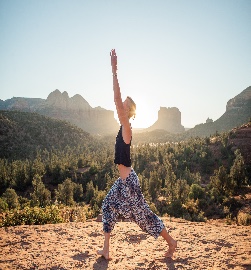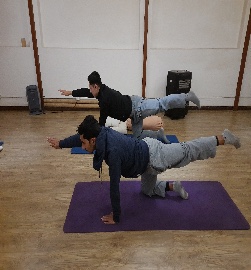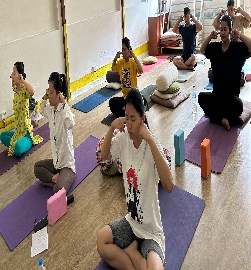At sunrise in Kathmandu, as the mist slowly lifts from the Kathmandu Valley and the scent of incense fills the air, something ancient stirs. The distant chime of a temple bell, the slow opening of a yoga mat, the first intentional breath—it is here, in this city cradled by the Himalayas, that one feels most profoundly that yoga is not just practiced, but lived.
Yoga in Kathmandu is unlike anywhere else in the world. It isn’t just movement; it’s memory. It is the memory of the body, the soul, and the cosmos. And to understand it fully, we must go back—not just centuries, but into myth, into spirit, into the profound silence from which yoga was born.
In a world where yoga is often reduced to postures and performance, this is an invitation to return to its sacred roots. This is the story of yoga—its myth, history, and meaning—and why Kathmandu is the perfect place to rediscover its soul.
The Mythic Origins of Yoga
Before it was ever written down, before the first sutra was scribed or the first pose performed, yoga was transmitted in silence. According to the ancient texts and oral traditions, yoga was first taught by none other than Lord Shiva, the Adi Yogi—the first yogi.
Legend tells of Shiva sitting in perfect stillness on Mount Kailash, immersed in meditation so deep that the rhythms of the universe pulsed through his breath. The Saptarishis, or seven sages, observed him in awe. Over time, Shiva broke his silence and began to transmit the secrets of yoga: breath control, inner stillness, physical discipline, and spiritual awakening.
These stories are not merely myth. In yoga, myth is a language of symbolism and insight—a way of describing states of consciousness that go beyond logic or words. Shiva is not just a god but a representation of the pure, formless self—the ultimate awareness that dwells in each of us.
And where do these myths find their echo today? In Kathmandu, where temples to Shiva, Vishnu, and Buddha stand side-by-side. Where the Bagmati River flows like a sacred artery through spiritual time. Where the air, heavy with history and incense, still speaks in whispers of those ancient transmissions.
Yoga in Kathmandu is myth made real.
The Historical Evolution of Yoga
From Vedas to Sutras
The earliest traces of yoga can be found in the Rig Veda, composed around 1500 BCE, where the seeds of spiritual inquiry were first sown. But it was in the Upanishads—composed between 800 and 500 BCE—that these seeds began to sprout into recognizable yogic philosophy.
Here, yoga was seen not as exercise, but as a path to moksha, or liberation. Breath control (pranayama), meditation (dhyana), and deep self-inquiry (jnana) emerged as methods to know the inner self and its connection to the universe.
Then came Patanjali, whose Yoga Sutras (circa 200 BCE) codified yoga into a structured system: the Ashtanga Yoga, or Eight Limbs of Yoga. These include:
-
Yamas – ethical restraints
-
Niyamas – personal observances
-
Asana – physical posture
-
Pranayama – breath control
-
Pratyahara – withdrawal of the senses
-
Dharana – concentration
-
Dhyana – meditation
-
Samadhi – union with the Divine
Patanjali’s work marked a turning point—it turned yoga into a practice, a discipline, a science of the soul.
The Paths of Yoga and Its Expansion
Over time, new paths of yoga evolved:
-
Bhakti Yoga: the path of love and devotion
-
Jnana Yoga: the path of wisdom
-
Karma Yoga: the path of selfless service
-
Raja Yoga: the path of meditation and control
These paths found fertile ground across India and Nepal, especially in regions like Kathmandu, where spiritual traditions intersected. The Newar Buddhists, Tantrikas, Shaivites, and Vaishnavas of the Kathmandu Valley cultivated unique blends of yogic practice, infused with ritual, mantra, and inner alchemy.
Yoga in Kathmandu – A Living, Breathing Tradition
Kathmandu is not just a place. It is a portal—a gateway into the sacred.
Here, yoga is practiced beneath the gaze of snow-capped peaks, in courtyards where monks chant at dawn, and in studios where breath and tradition intertwine. While global yoga trends have made their way to this valley, Yoga in Kathmandu remains deeply authentic, local, and grounded in lineage.
Sacred Sites and Spiritual Energy
-
Pashupatinath Temple: A powerful Shiva shrine, where yogis and sadhus gather daily.
-
Swayambhunath (Monkey Temple): A serene hilltop stupa, ideal for meditation and inner clarity.
-
Boudhanath Stupa: A Tibetan Buddhist sanctuary where prayer wheels spin alongside the rhythms of breath.
These are not just tourist sites—they are living sanctuaries for yoga, places where history and presence converge.
Modern Practice Rooted in Tradition
In recent years, yoga studios, ashrams, and retreat centers in Kathmandu have blossomed, offering everything from:
-
Hatha Yoga and Ashtanga Vinyasa
-
Vipassana meditation retreats
-
Ayurvedic healing and detox programs
-
Yoga teacher training certified by Yoga Alliance
But what makes Yoga in Kathmandu unique is its context. You’re not learning yoga in a vacuum—you’re living it in a landscape that has nurtured seekers for thousands of years.
You may find yourself practicing asana in a quiet rooftop space while monks chant nearby, or meditating beside a 1,000-year-old stupa as prayer flags flutter in the wind. This is yoga as it was meant to be: sacred, embodied, and deeply human.
Meaning – The Inner Journey of Yoga
More than anything, yoga is about meaning. It’s about transformation—not of the body, but of the self. In an era of disconnection and digital distraction, yoga invites us to return: to breath, to balance, to being.
Yoga Is Not a Performance
The modern world often treats yoga like a performance—measured by flexibility, Instagram poses, or class attendance. But the true aim of yoga is not to become better at yoga—it’s to become better at being alive.
Yoga in Kathmandu helps realign this purpose. Here, yoga is not a product; it’s a process. It’s not about escape; it’s about encounter—with your mind, your wounds, your joy, and your potential.
From Personal Practice to Personal Excellence
To walk the yogic path is to walk toward personal excellence. This does not mean perfection. It means awareness, integrity, discipline, and compassion. It means living in harmony with your values and your truth.
And what better place to explore this journey than in Kathmandu—where the sacred meets the everyday, and the ancient meets the now?
Here, you’ll meet teachers who are sages, students who are seekers, and a culture that breathes devotion.
Conclusion: The Spirit of Yoga is Alive in Kathmandu
The birth of yoga is a story that spans the heavens and the earth, the mythical and the material, the ancient and the ever-now. And that story is still being written—every time someone steps onto a mat in Kathmandu, every time a breath is taken with intention, every time a soul turns inward to listen.
Yoga in Kathmandu is more than a destination—it is a revelation. It is where myth becomes memory, history becomes practice, and meaning becomes lived experience.
So if you are looking not just to practice yoga but to truly understand it—to feel it in your bones, your breath, your being—then come to Kathmandu.
Here, yoga doesn’t just begin.
Here, yoga is born—again and again, within you.
Ready to Begin Your Journey?
Whether you seek inner peace, teacher training, or a transformative retreat, we welcome you to explore the heart of yoga.
👉 Discover authentic Yoga in Kathmandu with us:
Visit YogaInKathmandu.com to book a class, join a retreat, or begin your teacher training today.



